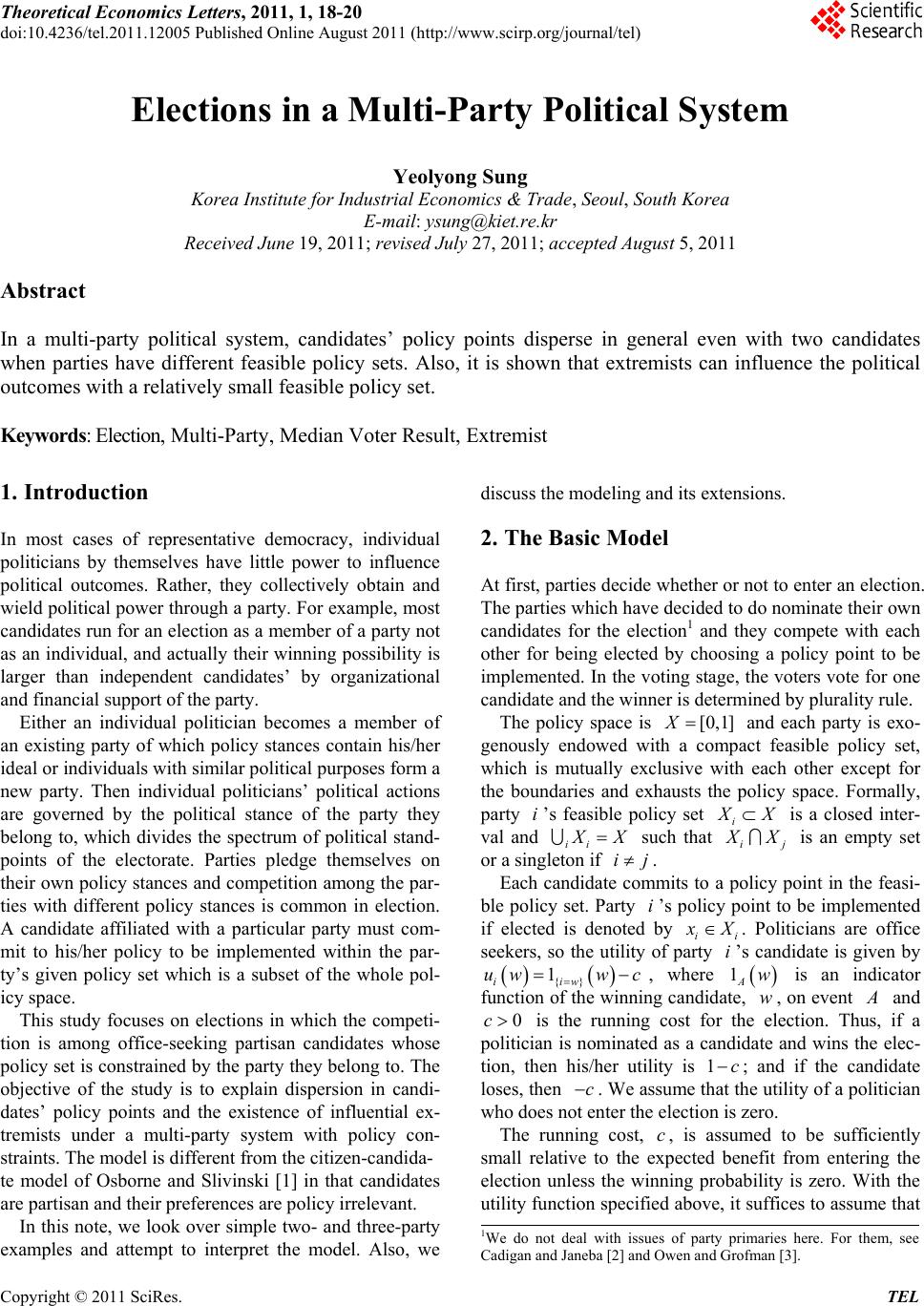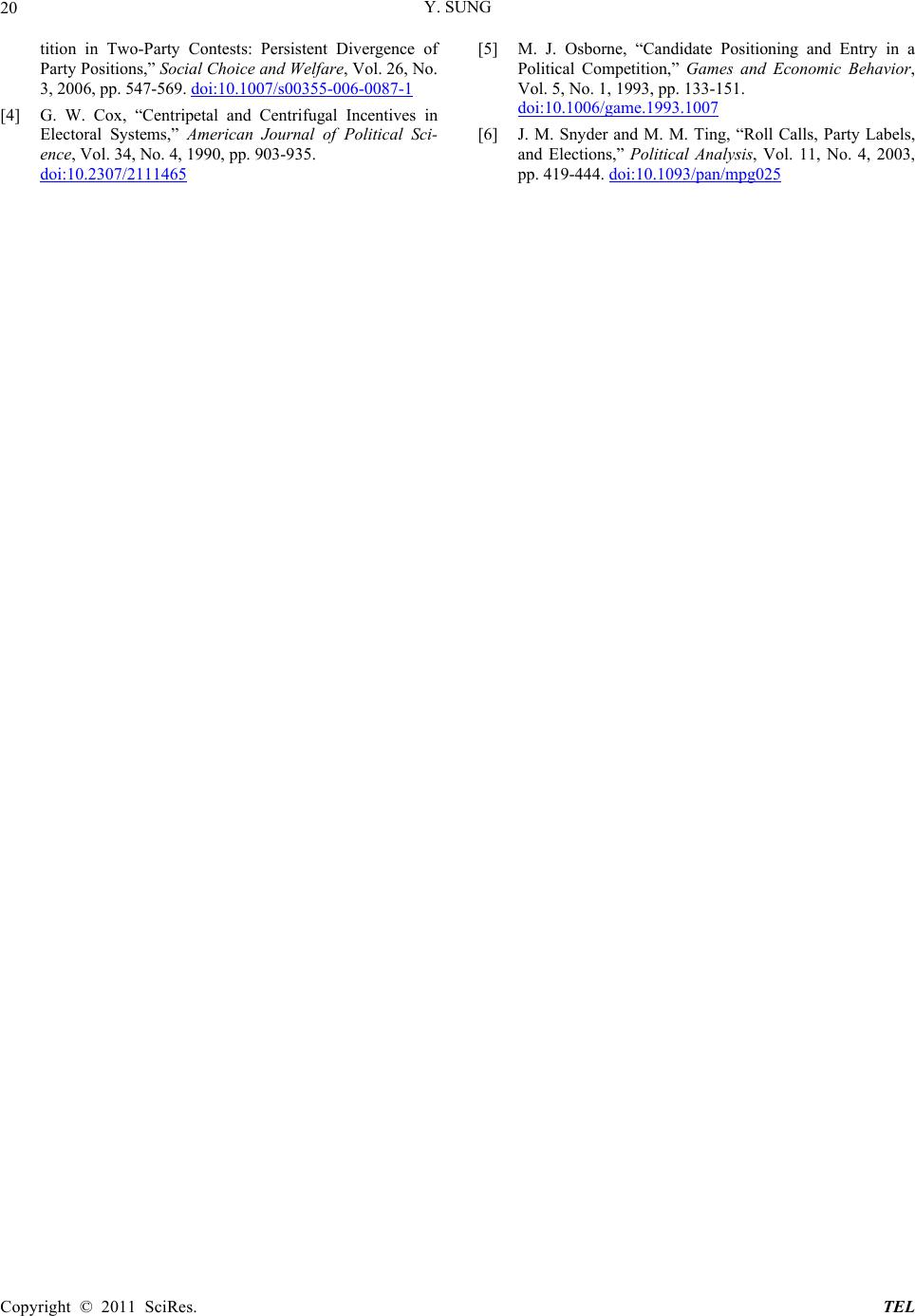Paper Menu >>
Journal Menu >>
 Theoretical Economics Letters, 2011, 1, 18-20 doi:10.4236/tel.2011.12005 Published Online August 2011 (http://www.scirp.org/journal/tel) Copyright © 2011 SciRes. TEL Elections in a Multi-Party Political System Yeolyong Sung Korea Institute for Industrial Economics & Trade, Seoul, South Korea E-mail: ysung@kiet.re.kr Received June 19, 2011; revised July 27, 2011; accepted August 5, 2011 Abstract In a multi-party political system, candidates’ policy points disperse in general even with two candidates when parties have different feasible policy sets. Also, it is shown that extremists can influence the political outcomes with a relatively small feasible policy set. Keywords: Election, Multi-Party, Median Voter Result, Extremist 1. Introduction In most cases of representative democracy, individual politicians by themselves have little power to influence political outcomes. Rather, they collectively obtain and wield political power through a p arty. For example, most candidates run for an election as a member of a party not as an individual, and actually their winn ing possibility is larger than independent candidates’ by organizational and financial suppo rt of the party. Either an individual politician becomes a member of an existing party of which policy stances contain his/her ideal or individuals with similar political purposes form a new party. Then individual politicians’ political actions are governed by the political stance of the party they belong to, which divides the spectrum of political stand- points of the electorate. Parties pledge themselves on their own policy stances and competition among the par- ties with different policy stances is common in election. A candidate affiliated with a particular party must com- mit to his/her policy to be implemented within the par- ty’s given policy set which is a subset of the whole pol- icy space. This study focuses on elections in which the competi- tion is among office-seeking partisan candidates whose policy set is constrained by the party they belong to. The objective of the study is to explain dispersion in candi- dates’ policy points and the existence of influential ex- tremists under a multi-party system with policy con- straints. The model is different from the citizen-candid a - te model of Osborne and Slivinski [1] in that candidates are partisan and their preferences are policy irrelevant. In this note, we look over simple two- and three-party examples and attempt to interpret the model. Also, we discuss the modeling and its extensions. 2. The Basic Model At first, parties decide whether or not to enter an election. The parties which have decided to do nominate their own candidates for the election1 and they compete with each other for being elected by choosing a policy point to be implemented. In the voting stage, the voters vote for one candidate and the winner is determined by plurality rule. The policy space is [0,1]X and each party is exo- genously endowed with a compact feasible policy set, which is mutually exclusive with each other except for the boundaries and exhausts the policy space. Formally, party ’s feasible policy set ii X X is a closed inter- val and ii X X such that ij X X is an empty set or a singleton if ij . Each candidate commits to a policy point in the feasi- ble policy set. Party ’s policy point to be implemented if elected is denoted by ii i x Xi. Politicians are office seekers, so the utility of party ’s candidate is given by {} 1 iiw uww c , where is an indicator function of the winning candidate, , on event w w 1A A and is the running cost for the election. Thus, if a politician is nominated as a candidate and wins the elec- tion, then his/her utility is 1; and if the candidate loses, then 0c cc . We assume that the utility of a politician who does not enter the election is zero. The running cost, , is assumed to be sufficiently small relative to the expected benefit from entering the election unless the winning probability is zero. With the utility function specified above, it suffices to assume that c 1We do not deal with issues of party primaries here. For them, see Cadigan and Janeba [2] and Owen and Grofman [3].  Y. SUNG 19 c is always less than the winning probability if it is strictly positive, which is the expected benefit from en- tering the election. Thus, the utility function implies that if a party expects that it will lose the election with prob- ability 1, then it does not enter the election because no member of the party wants to be a candidate. The set of voters is a continuum , and each voter’s preference on the policy space is symmetric and single-peaked. Voters’ ideal policy points are uniformly distributed on . We assume that each voter votes for the most preferred candidate sincerely2. A can- didate who obtains the most votes is elected and his/her announced policy is implemented. If there is a tie, each candidate with the most votes has equal probability of winning. [0,1]V [0,1] X 3. Two-Party System Consider a two-party system with the Leftist () party and the Rightist () party. In this case, both parties en- ter the election only if they are balan ced in terms of their policy stances. If the sizes of the feasible policy sets are different, only the party with the larger set enters the elec- tion and wins by acclamation. For example, let L R ˆ x12,1 and suppose that ˆ 0, L X x and ˆ,1 R Xx. Then the Leftist can win the election by an- nouncing any policy point ˆˆ ,1 L x xx and so the Rightist does not enter the election because then it loses with probability 1. Only when the feasible sets of the parties equally divide the policy space (ˆ x12), both parties compete on the elec- tion and the policy points are 12 LR xx with each party’s winning probability of 12. 4. Three-Party System For convenience, suppose that three parties, the Leftist (), the Moderate (L M ) and the Rightist (), represent three groups, respectively, corresponding to their feasible policy sets which divide the policy space symmetrically around the median R 12, that is, [0, ] L X x, ,1 M X xx and [1 ,1] R X x for some [0,1 2]x. We have three kinds of electoral outcome depending on the value of x . First, if [0,16)x, the only candidate comes from the Moderate and is elected by choosing 3,1 3 M x xx. Second, if (16,12]x, only the two extremists enter the election with the policy points of L x x and 1 R x x , re- spectively. This example shows that the median voter result does not hold in two candidate competition be- cause the candidates’ policy choices are restricted out of the median. Third, if 16x, all the three parties com- pete on the election at the policies 16 L x, 12 M x and 56 R x with equal winning probability. The lit- erature reports that equilibrium may not exist with three (or more) candidates (Cox [4], Osborne [5]), but the pol- icy constraint that the median point cannot be shared by the candidates guarantees the existence of equilibrium. 5. Conclusions The two-party and three-party competition in the above sections show that candidates’ policy points disperse in general even with two candidates when parties have dif- ferent feasible policy sets. The constraint on the policy sets makes the parties’ entry decision strategic and leads to the dispersio n in policies. Also, it is shown that in po- litical systems with more than two parties, extremists can influence the political outcomes even though their feasi- ble policy sets are relatively small, while a moderate can do so with a relatively large feasible set. This is because sincere voters close to an extremist’s policy point cast the vote for the ex tremist even thoug h their ideal lies in a moderate party’s policy set. In this note, only two- and three-party political sys- tems were considered. But the analysis can be extended to an arbitrary -party system in which the feasible policy sets of the parties divide the policy space symmet- rically around the median voter’s ideal point. The above results are preserved as well in the model with par- ties. There are a couple of things to be more studied in this research. First of all, endogenous party formation should be studied. In the basic model, the feasible po licy set of a party was exogenously given. However, it is de- termined in the course of the formation or the evolution (expansion, contraction, mergence, or division) of the party3. Second, if the candidate of a party was policy motivated within the feasible set, then he/she could not commit to a policy poin t4. N N 6. References [1] M. J. Osborne and A. Slivinski, “A Model of Political Competition with Citizen-Candidates,” Quarterly Journal of Economics, Vol. 111, No. 1, 1996, pp. 65-96. doi:10.2307/2946658 [2] J. Cadigan and E. Janeba, “A Citizen-Candidate Model with Sequential Elections,” Journal of Theoretical Poli- tics, Vol. 14, No. 4, 2002, pp. 387-407. doi:10.1177/095162902774006804 [3] G. Owen and B. Grofman, “Two-Stage Electoral Compe- 3As an example of evolution, Owen and Grofman [3] attempt to ex- p lain dynamics of the split of the policy space in a two-party competi- tion with primary election. 4For reference, Snyder and Ting [6] analyze a model of legislative p olicy making in which legislators have two means of communica t ing their preferences to voters: party labels and roll call votes. 2If it is assumed that the set of voters is a continuum and the number o f the members of each party is finite, then the finite partisan voters’ influence on the election is negligible. Copyright © 2011 SciRes. TEL  Y. SUNG Copyright © 2011 SciRes. TEL 20 tition in Two-Party Contests: Persistent Divergence of Party Positions,” Social Choice and Welfare, Vol. 26, No. 3, 2006, pp. 547-569. doi:10.1007/s00355-006-0087-1 [4] G. W. Cox, “Centripetal and Centrifugal Incentives in Electoral Systems,” American Journal of Political Sci- ence, Vol. 34, No. 4, 1990, pp. 903-935. doi:10.2307/2111465 [5] M. J. Osborne, “Candidate Positioning and Entry in a Political Competition,” Games and Economic Behavior, Vol. 5, No. 1, 1993, pp. 133-151. doi:10.1006/game.1993.1007 [6] J. M. Snyder and M. M. Ting, “Roll Calls, Party Labels, and Elections,” Political Analysis, Vol. 11, No. 4, 2003, pp. 419-444. doi:10.1093/pan/mpg025 |

